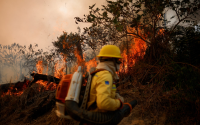Common Dreams / Published on Monday, August 25, 2003 by the New York Timesby Scott Ritter
DELMAR, N.Y. — Some 1,500 American investigators are scouring the Iraqi countryside for evidence of weapons of mass destruction that has so far eluded them. Known as the Iraq Survey Group and operating under the supervision of a former United Nations weapons inspector, David Kay, they are searching mostly for documents that will help them assemble a clear, if somewhat circumstantial, case that Iraq had or intended to have programs to produce prohibited weapons.
It is a daunting task. And according to many Iraqi scientists and officials I have spoken to, it is not being done very well.
A logical starting place for such a mission is in the Jadariya district of downtown Baghdad, adjacent to the campus of Baghdad University: the complex that housed the Iraqi National Monitoring Directorate. The directorate was the government agency responsible for coordinating all aspects of the United Nations inspection teams' missions. It was also supposed to monitor Iraq's industrial infrastructure and ensure compliance with the Security Council resolutions regarding disarmament, verification and export-import controls.
As such, the directorate was the repository for every Iraqi government record relating to its weapons programs, as well as to the activities at dozens of industrial sites in Iraq that were "dual-use" — used to manufacture permitted items but capable of being modified to manufacture proscribed material.
For 12 years the Iraqis collected and collated this data. If we inspectors had a question about a contract signed between country A and Iraqi factory B, the directorate could produce it at short notice. The 12,500 page "full, final and complete declaration" provided by Iraq to the United Nations in the fall of 2002 was compiled using this archive. And the directorate's holdings went well beyond paperwork: every interview conducted by the United Nations inspectors with Iraqi scientists throughout the 1990's was videotaped and available for review.
Of course, all this material was put together by officials and scientists who were obedient, either out of loyalty or fear, to the former regime, and it was done in a way intended to prove that Iraq was complying with the United Nations resolutions (something that has not been proved false in the five months since the American-led invasion). Still, even if one was to discount the entire archive as simply a collection of Iraqi falsifications, it would still be a sound foundation on which the Iraq Survey Group could have started investigations. After all, some of my most fruitful efforts as a United Nations inspector were initiated using false claims by the Iraqi government as the starting point.
And it seems that after the coalition troops moved into Baghdad, the records were all there for the taking. According to several senior directorate officials I have spoken to since the war — one a brigadier general who had been a high-ranking administrator at the complex — the entire archive had been consolidated into metal containers before the war and stored at the directorate's Jadariyah headquarters for protection.
Yet these eyewitnesses have provided me with a troubling tale. On April 8, they say, the buildings were occupied by soldiers from the Army's Third Infantry Division. For two weeks, the Iraqi scientists and administrators showed up for work but, according to several I have spoken to, no one from the coalition interviewed them or tried to take control of the archive.
Rather, these staff members have told me, after occupying the facility for two weeks, the American soldiers simply withdrew. Soon after, looters entered the facility and ransacked it. Overnight, every computer was stolen, disks and video records were destroyed, and the carefully organized documents were ripped from their binders and either burned or scattered about. According to the former brigadier general, who went back to the building after the mob had gone, some Iraqi scientists did their best to recover and reconstitute what they could, but for the vast majority of the archive the damage was irreversible.
Obviously, I am relying on the word of former directorate officials, but these are people I knew well in my days as an inspector, and none would seem to have anything to gain by lying today. In any case, the looting of the building, if not the previous presence of American troops, has been well documented by Western news reports.
Why was this allowed to happen? I am as puzzled as the Iraqis. Given the high priority the Bush administration placed on discovering evidence of weapons of mass destruction, it seems only logical that seizing the directorate archive would have been a top priority for the coalition forces — at least as important as the Iraqi Oil Ministry or the National Museum. And it seems highly unlikely that coalition leaders didn't know what the archive contained. I was one of many international inspectors who led investigations of the facility — and the data we produced was used by the American government as part of its case that Saddam Hussein was hiding prohibited programs.
Today, with the tremendous controversy over the administration's pre-war assertions, it is impossible to overstate the importance of the archive that produced Iraq's 12,500 pages of claims — none of which have yet been shown to be false — that comprise the most detailed record of Iraq's weapons programs.
Next month the Iraq Survey Group will give a formal briefing to American and British officials on the status of its investigations. President Bush has already hinted that the group will make a case that it has found evidence of prohibited weapons programs and of efforts to hide them from international inspectors. Such a case may have merit, but without being able to compare and contrast it to the Iraqi version of events, I'm not sure how convincing it will be to the American public, or to the rest of the world.
Scott Ritter is a former United Nations weapons inspector in Iraq and author of "Frontier Justice: Weapons of Mass Destruction and the Bushwhacking of America."






